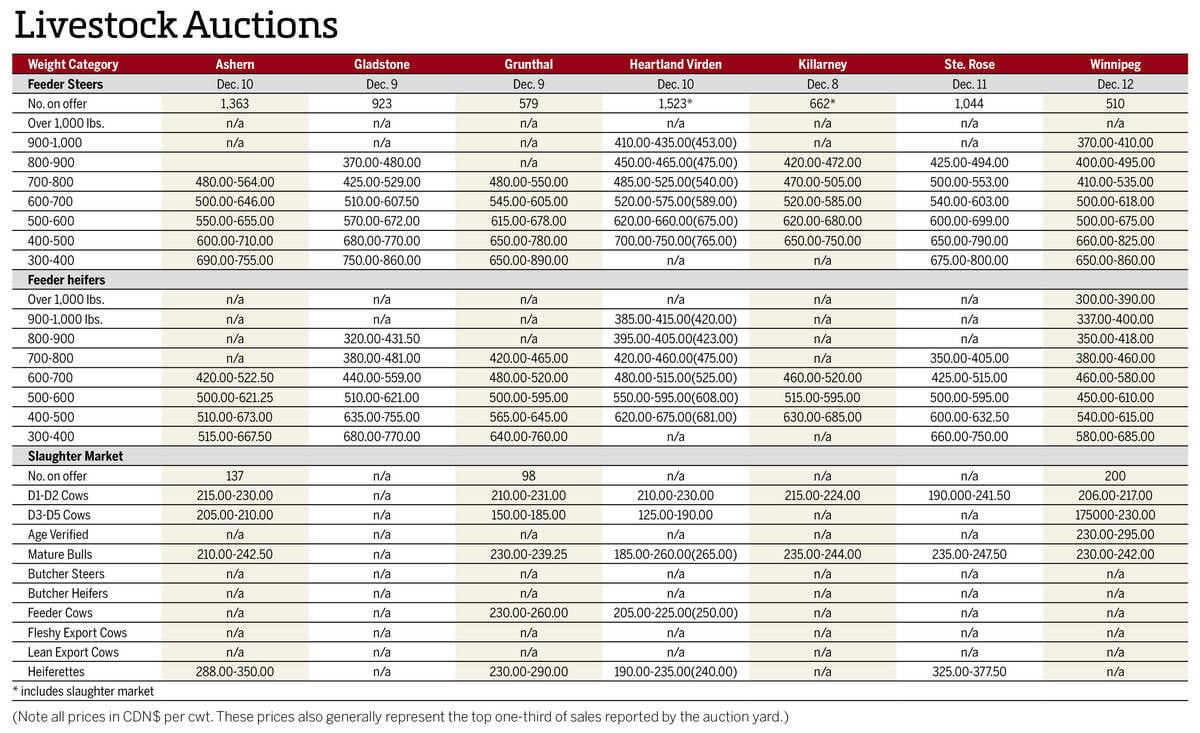Reuters – U.S. soybean exports had a dismal April performance and possibly an even worse showing in May as shipments to China remain historically low, but corn exports hit a one-year high in April and improved on those volumes last month.
Soybean sales were relatively strong in May and that could continue since the U.S. oilseed is now cheaper than its Brazilian competitor. With U.S. corn also favourably priced, healthy sales of both are possible in the coming weeks, and those are needed to reach government export expectations.
Read Also

Manitoba cattle prices Dec. 16
Here’s what local farmers were getting paid last week for their cattle at Manitoba livestock auction marts; prices covering the week Dec. 8-12, 2025.
However, soybean shipments to China remain well below the expectations implied by the Phase 1 trade agreement.
The United States exported 2.16 million tonnes of soybeans in April, down 10 per cent from the previous year and the smallest volume for any month since June 2017. That is according to data published recently by the U.S. Census Bureau.
April shipments to top buyer China totalled 423,891 tonnes, down 20 per cent on the year but more than twice the March volume.
Total May exports were likely even worse, possibly not even cracking two million tonnes. Last month’s shipments to China were in the vicinity of 200,000 tonnes, which would be the smallest for any month since December 2018.
Soybean exports to China are by far the United States’ biggest agricultural trade relationship, which is why the oilseed probably has a great deal of legwork to do if the Phase 1 trade deal between the two countries were to be fulfilled.
That deal calls for China’s 2020 U.S. agricultural imports to rise more than 50 per cent over 2017 levels, making the recent snail’s pace of U.S. soybean shipments to China even more alarming.
The U.S. Department of Agriculture last month predicted U.S. soybean exports in the 2019-20 marketing year ended Aug. 31 to fall four per cent on the year to 1.675 billion bushels (45.6 million tonnes). That was down from the April projection of 1.775 billion.
At the end of last month, exporters still had nearly three million tonnes of soybeans to sell to hit the agency’s number. That is 18 per cent above the recent five-year average but much more realistic when comparing unsold soybeans with USDA’s previous export forecasts.
Old-crop soybean sales were very healthy last month, topping three million tonnes, more than double the average of the past five Mays. That includes around 1.5 million tonnes to China.
China’s participation is going to be needed to continue the high selling pace over the next three months. China has been historically quiet in the U.S. soybean market so far in calendar year 2020, as exports to the Asian country likely totalled around 3.5 million tonnes through May, the lightest for the period in 16 years.
Some analysts have suggested China would need to purchase and import up to 40 million tonnes of U.S. soybeans in 2020 to fulfil the Phase 1 deal. If true, some 36.5 million tonnes of beans remained by the end of May, more than the United States has ever shipped to China in a whole calendar year, let alone in seven months.
The incredible volumes coming out of No. 1 exporter Brazil have been a major speed bump in the U.S. plan. China’s soybean needs are not as robust as a couple of years ago, so it is hard to imagine such an unprecedented reliance on U.S. supplies given how many Brazilian beans have shown up at Chinese ports in recent months.
In theory, Brazil’s blazing shipment pace should imply that exporters there will run out of soybeans by the time the traditional U.S. shipping period arrives later this year. But somehow, Brazil has not run out of beans in nearly two years.
U.S. corn exports hit 5.06 million tonnes in April, the largest monthly volume in one year but down eight per cent from April 2019. That was also the smallest April total in four years.
May shipments were better, likely coming in between 5.5 million and six million tonnes. That would be the biggest monthly volume since July 2018 on the high end and October 2018 on the low end.
USDA last month increased its prediction for 2019-20 exports by 50 million bushels over the April peg to 1.775 billion bushels (45.1 million tonnes). Reaching that target would require shipments between June and August, the final three months of the year, to average around 4.6 million tonnes per month. That is slightly below the recent five-year mean.
U.S. corn sales likely exceeded three million tonnes last month, a strong showing considering that South America has not had a widespread drought this year.
As of May 28, export sales were still about 4.6 million tonnes short of USDA’s annual target, about 20 per cent above average June-August sales in the last five years. But much different from a year ago, U.S. exporters have price competitiveness on their side right now, so the lofty sales goal may be possible.















